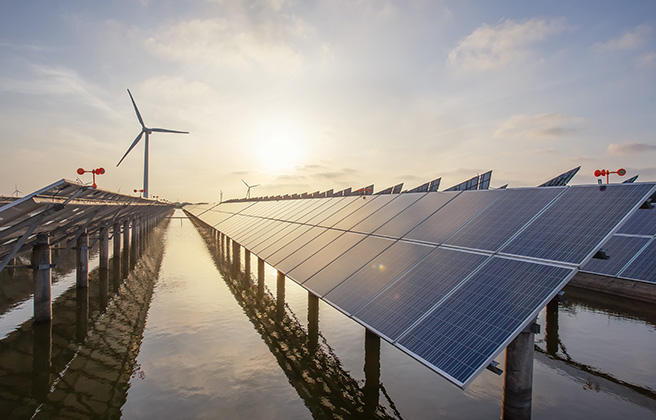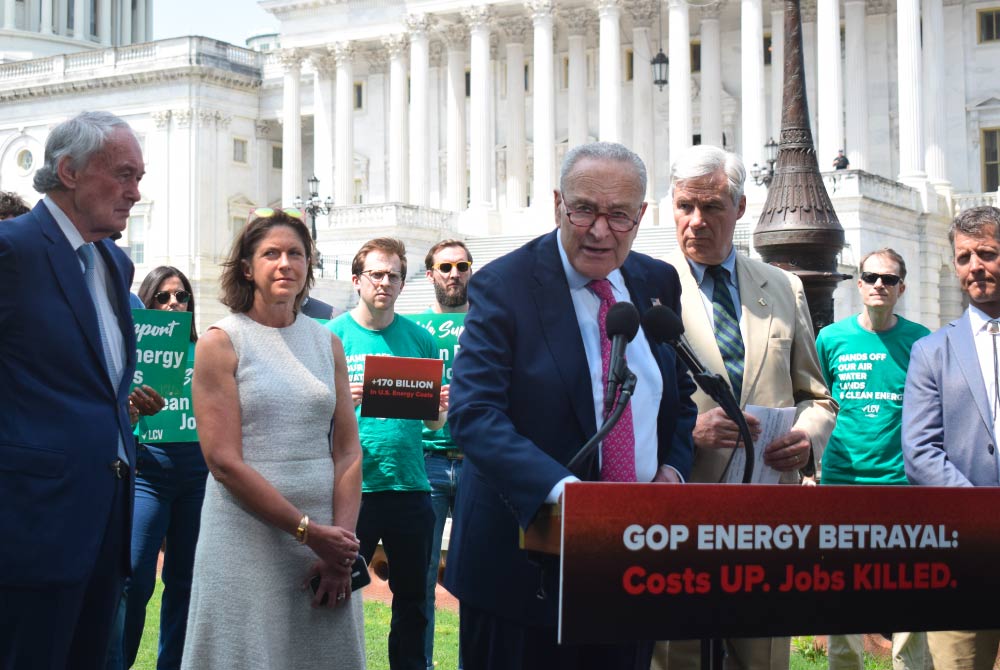
Good Climate News for October 2025: Cheaper Clean Energy Wins Over Expensive, Dirty Fossil Fuels
Nov 10, 2025
 Senate Minority Leader Chuck Schumer (NY) speaks in front of the U.S. Capitol with LCV staff advocating for clean energy tax credits and funding threatened by Republicans’ Big Ugly Bill. Photo credit: Jessie Cohen, LCV
Senate Minority Leader Chuck Schumer (NY) speaks in front of the U.S. Capitol with LCV staff advocating for clean energy tax credits and funding threatened by Republicans’ Big Ugly Bill. Photo credit: Jessie Cohen, LCV
Each month, LCV shares five stories about the impact of our work. This month, we’re focusing on how we opposed the Big Ugly Bill and what’s next — along with more than a dozen state-level clean energy wins, new commitments in Maine and Ohio, and new clean water protections in Texas.
LCV and the Conservation Voters Movement (CVM) will never stop fighting for our climate and for an equitable and just clean energy future. Earlier this month, Republicans in Congress passed their so-called “Big, Beautiful Bill” — and it will have extremely ugly impacts for our environment and our communities. LCV and our CVM state affiliates ran robust grassroots engagement, mobilization, and advocacy efforts across the country to try to blunt the worst components of this Big Ugly Bill.
Despite our best efforts, the bill narrowly passed the House and Senate. Said LCV President Pete Maysmith, “This law is a disaster, and the Republicans in Congress who voted for it have demonstrated that they don’t care about our families, our environment or our future. Their hope is that in the long term, we’ll forget about this. That is not going to happen.”
Leading up to the final votes, LCV and our state affiliates worked across the country to pressure leaders to block the worst parts of this bill. Collectively, we:
Climate champions in the House and Senate stood strong in their attempts to soften the blow of this legislation, and this solidarity provides a foundation for future work.
LCV and our state affiliates will never stop fighting for clean air and water, lower energy costs, and the safe and equitable climate future we all deserve. And we stand side by side with others who vow to do the same.
As we push onward at the federal level, we also continue to make great gains in the states, as demonstrated in the stories below.
Dig Deeper: Learn more about how the Big Ugly Bill impacts clean energy, electricity costs, the environment, and more.
When Trump won the White House back in 2016, we knew federal climate action was unlikely. So, LCV pivoted and began investing heavily in winning and implementing state-level policy solutions. Thanks to the work of LCV and our state affiliates in the Conservation Voters Movement (CVM), today, more than 40% of people in the U.S. live in states and cities committed to 100% clean energy — up from 1% when we began this work.
Since then, we’ve built the CVM into a nationwide powerhouse that helps state affiliates learn from each other’s strategies, adapt them to their unique settings, and win big on climate and clean energy progress. Today, despite federal setbacks, our progress protecting communities and advancing clean energy continues, thanks to the growing strength of the CVM.
Connecticut committed to net-zero climate emissions economy-wide by 2050.
Illinois created a task force to study climate displacement impacts and create plans for supporting the most affected communities.
Minnesota set new regulations to prevent utilities from passing the costs of data centers’ soaring energy demands on to ratepayers, and from using data centers as an excuse to avoid reaching the state’s 100% clean energy by 2040.
Nevada passed legislation requiring the state’s two most populated counties to include extreme heat mitigation strategies in their long-term development plans. The state also enacted laws ordering utilities to fully refund overcharged customers and expanding access to solar for multifamily residential properties.
New York repealed the decades-old 100-foot rule that incentivized dirty gas use by requiring utility customers to subsidize other people’s gas hookups.
Oregon mandated climate change education in public schools and protected ratepayers by creating a separate electric rate pricing system for large energy users such as data centers and cryptocurrency operations.
Vermont’s new law promotes faster, cheaper residential solar by removing unnecessary barriers to deploying small solar arrays.
Washington set requirements and incentives for building mixed-income housing near transit under its new transit-oriented development law.
Colorado adopted new statewide building energy codes that include requirements for energy efficiency and solar and electric vehicle charging readiness.
Massachusetts revamped its solar incentive program to ensure the state’s solar progress continues despite cuts to federal clean energy funding.
New Jersey announced over $430 million in direct utility bill relief, including at least $100 for all residential ratepayers and $150+ for lower-income households.
New York announced $136 million to fully fund the first phase of decarbonizing the Empire State Plaza, home of the state capitol.
New York’s Empire Wind project resumed construction after the Trump administration had issued a stop work order for the offshore wind project.
Ohio’s Power Siting Board approved Frasier Solar, a 120-megawatt agrivoltaic project that will allow for sheep grazing in addition to solar panels.
Oregon launched a heat pump incentive program offering up to $2,000 in rebates for more efficient and cleaner home heating and cooling.
Pennsylvania awarded grants to 73 schools across the state to install solar panels as part of the Solar for Schools program.
Wisconsin’s first large-scale battery energy storage facility is now operational, storing enough energy to power more than 130,000 homes for up to four hours.
Thanks in large part to state and local action, clean energy production continues to rise. This year in the U.S., wind and solar energy generated more electricity than coal for the first time, accounting for 17% of the nation’s power mix.
LCV’s state affiliate, Maine Conservation Voters (MCV), used a multipronged approach to accelerate the state’s timeline for achieving 100% clean energy by 10 years, moving the statutory deadline to 2040 from 2050.
Maine Conservation Voters (MCV) and its sister organization, Maine Conservation Alliance (MCA), played pivotal roles in this win through legislative and administrative advocacy respectively, including:
Dig Deeper:
By engaging and mobilizing communities, Chispa Texas, a program of LCV, helped secure legislation that addresses the state’s burgeoning water crisis by protecting access to clean water and increasing water affordability.
This legislation will meet the needs of communities, cities, farms, ranches, and businesses through a $20 billion investment over 20 years to:
The legislation also gives the state’s water development board greater oversight to measure performance and accountability and will increase water affordability for Texans.
Dig Deeper: Read more about the recently signed legislation.
Ohio’s recently approved 120-megawatt solar project marks another milestone in advancing responsibly developed clean and renewable energy in the state. The Frasier Solar project, a priority of LCV’s state affiliate, the Ohio Environmental Council (OEC), will help address increasing demand on the electricity grid and help ensure that Ohioans benefit from reliable, affordable clean energy.
The Best Thing You Can Do Right Now
The Western Arctic is one of the most ecologically important landscapes in the world. It’s home to polar bears, wolves, moose, enormous caribou herds, and nesting birds from across the globe. The Trump administration aims to dismantle protections for this fragile landscape — which also supports subsistence hunting traditions crucial to Alaska Natives and serves as a critical carbon sink, stabilizing planetary temperatures and reducing the effects of climate change.
Help Protect the Western Arctic